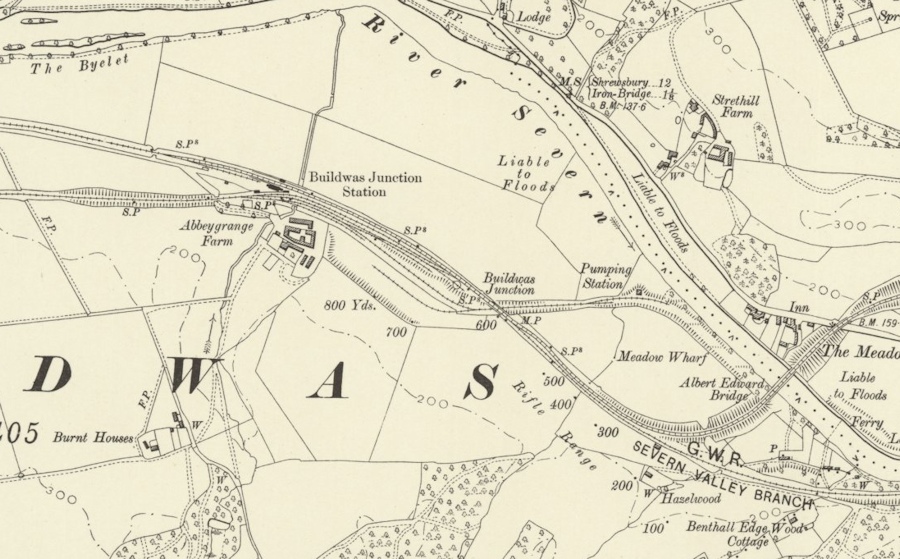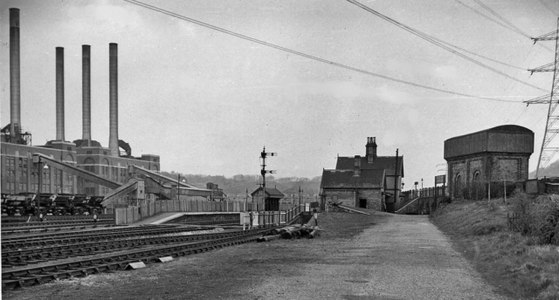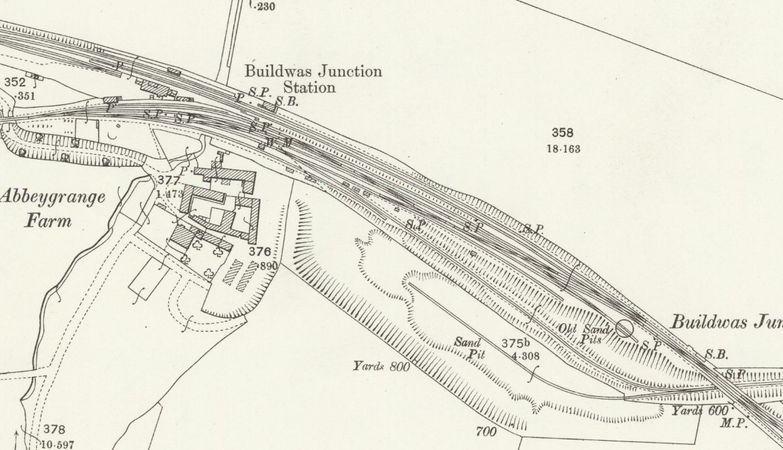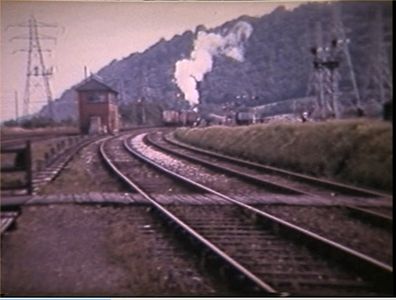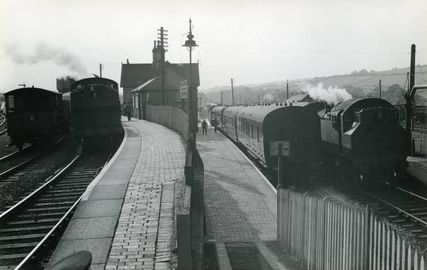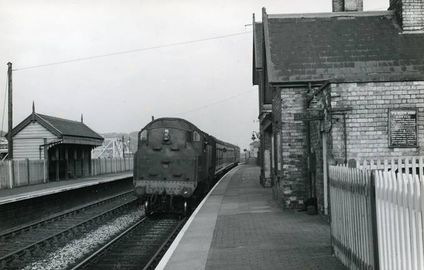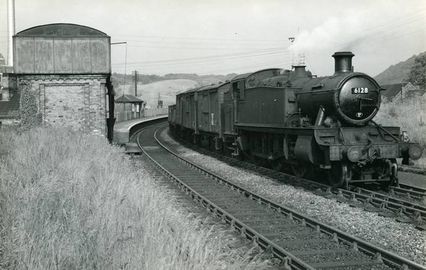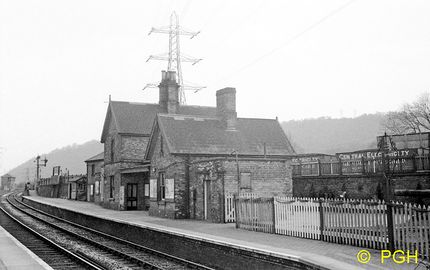Buildwas
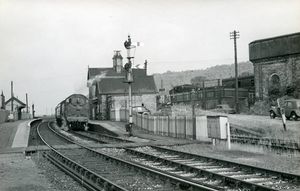

| Towards Hartlebury and Kidderminster | Towards Shrewsbury |
|---|---|
| Ironbridge (1½ miles) | Cressage (4 miles) |
Buildwas station was situated 28½ miles from Hartlebury and 12¼ miles from Shrewsbury. It served both the Severn Valley Branch and the Wellington to Craven Arms Railway, although it was an interchange station in open countryside with little passenger access except by rail.[1][2][note 1] The station building was of a similar design to that at Bewdley.
West of Buildwas the Severn Valley line left the Severn Valley gorge and entered the flatter flood plain area leading towards Shrewsbury.
History
When the Severn Valley Railway opened on 1 February 1862, Buildwas Station was the first station at which trains leaving and approaching Shrewsbury could cross (passing loops were later installed at the intermediate stations of Berrington and Cressage). It also served the Much Wenlock line (the Much Wenlock and Severn Junction Railway before its incorporation into the GWRGreat Western Railway in 1895) which opened on the same day and on which it was the northern terminus. The station had three platforms, two serving the Severn Valley Branch and one on a higher level serving the Much Wenlock line.
Prior to the opening of both railways, the Board of Trade inspector Colonel Yolland published a report on 30 December 1861 listing matters which required attention before he could recommend opening for public traffic. He noted that the turntable at Buildwas was not yet complete. He also suggested changes to the layout at Buildwas due to the gradients on the Much Wenlock line as it approached the station; these included doubling a short length of the Severn Valley line and making a double junction with a safety siding. He carried out a further inspection on 15 January 1862, during which he noted that the improvements at Buildwas were being undertaken, including completion of a second platform on the Severn Valley line. His report on 23 January 1862 recommended that the Board of Trade should sanction opening. Both railways opened on 1 February 1862.[3]
The Much Wenlock, Craven Arms and Coalbrookdale Railway, usually termed the Wenlock Railway, was incorporated on 22 July 1861. It completed the section of the Wellington to Craven Arms Railway northwards between Buildwas and Coalbrookdale via Albert Edward Bridge which opened on 1 November 1864 as part of the Wellington to Craven Arms Railway.
On 10 May 1899 the GWRGreat Western Railway traffic committee agreed to provide a private siding to serve Mr Griffith's sand fields at an estimated cost to him of £138.[4]
The OSOrdnance Survey Map below shows the layout at Buildwas as surveyed in 1901. The Severn Valley Branch (labelled) runs from north-west to south east passing to the north of the station building, while the line from Much Wenlock enters from the south-west and passes south of the station building. This branch provided access to a marshalling yard and the turntable whose location can be seen. A short siding continued to a GWRGreat Western Railway pumping station on the banks of the River Severn. The through route from the Much Wenlock line towards Coalbrookdale, which opened in 1864 and was double track, continues via Albert Edward Bridge. The station approach road, which also served Abbeygrange Farm, ran parallel with the Severn Valley Branch as far as the Buildwas to Much Wenlock Road (now the A4169), which the Branch crossed via a level crossing controlled by a ground frame.[1]
All these features were present on the earlier OSOrdnance Survey map surveyed in 1881 apart from the southernmost siding which the map shows was accessed by a reversal from the pumping station siding; this is presumably Mr Griffith's siding of 1899.
The passing loop at Buildwas was lengthened in 1904.[4]
GWR staff records for 1922 show the station had a staff of 12.
In February 1927 the area between the station and the River Severn was selected to be the site of a new power station (later to become known as Ironbridge A Power Station). Construction began in 1929 with much of the materials arriving by rail. This required the expansion of the 1923 signal box (see below) to control the extensive additional sidings and the coal traffic. The facility was officially opened on 13 October 1932 with a train of dignitaries arriving by train from Paddington.[5] The station also handled limestone traffic from the quarries on Wenlock Edge.
Passenger services from Craven Arms via Much Wenlock ceased on 31 December 1951, and between Wellington and Much Wenlock via Buildwas on 23 July 1962. In the same year Parliamentary approval for Ironbridge B Power Station was sought and granted, even though consent for the closure of the Severn Valley Branch had not yet been given. Buildwas station closed along with the Severn Valley Line in September 1963, but the line to Buildwas remained open from Longville (south of Wenlock) for freight until 4 December 1963 and from Ketley (on the Wellington line) until 6 July 1964. Buildwas was demolished in 1964 to make way for a new coal handling plant for the power station. Coal traffic for Ironbridge B Power Station continued from Madeley Junction, on the main line between Shifnal and Telford Central, until 2016.
Signalling
Early signalling on the SVRSevern Valley Railway was primitive, with entry of trains into the platform controlled by signals operated from levers on the platform and departures controlled only by telegraph instruction.[6] On 30 August 1871 the GWRGreat Western Railway Board authorised £22 for "...connecting the down starting signal with the Signal Box at Buildwas station", although this was probably only a small cabin covering a ground frame.[7] It is labelled on the map below, but no building is shown associated with it. Another ground frame was situated at the junction of the Severn Valley and Coalbrookdale branches (present but unlabelled on the map below, bottom right).
Installation of the first 'proper' signal boxes on the Severn Valley Branch began at Bewdley in 1878 as part of the opening of the Kidderminster Loop Line. The other signal boxes all dated from after 1880.[8][note 2] On 4 February 1886 the Board authorised the block telegraph to be installed between Buildwas and Much Wenlock. On 16 November 1887 further work was authorised at a cost of £2,080 including provision of two signal boxes (one at the station and the other at the junction of the Severn Valley Branch and the double-track Coalbrookdale line), renewal of locking apparatus and signals, and completing the block telegraph. The two boxes opened in 1888. Working by telegraph continued until October 1891 when train staff and ticket working in conjunction with the single-needle block telegraph was introduced. In January 1894 this became Electric Staff working between Hartlebury Junction and Buildwas Junction, followed shortly afterwards by the section to Shrewsbury.[9]
On 12 April 1905 the renewal of the interlocking frame and point and signal connections at Buildwas was authorised at a cost of £692.[10]
In November 1923 the two signal boxes at Buildwas were replaced by a central signal box. This was a GWRGreat Western Railway Type 7D brick signal box with a 66-lever frame.[11] A new 113 lever frame was brought into use on 9 December 1931 to handle the new layout and connections into the Power Station sidings.[12] It was then the largest box on the Severn Valley Branch; the more remote points were motorised.[13]
Buildwas box closed on 15 March 1964.[14] A Buildwas Signal Box nameplate is on display at the Chasewater Railway Museum.
Station name
The station was named Buildwas in timetables, and also appeared as such in the 1963 notice of closure. However the station running in board showed the name as “Buildwas Junction”;[15] this version was also shown on Ordnance Survey maps as above.
Traffic statistics
| Passenger Traffic | Freight Traffic | |||||
|---|---|---|---|---|---|---|
| Year | Tickets issued | Parcels despatched | Revenue (£) | Tons received & despatched | Revenue (£) | Total revenue (£) |
| 1903 | 9,693 | 1,258 | 598 | 3,831 | 700 | 1,298 |
| 1913 | 9,601 | 2,445 | 582 | 3,980 | 600 | 1,182 |
| 1923 | 7,098 | 1,023 | 432 | 3,838 | 755 | 1,187 |
| 1933 | 5,983 | 1,029 | 489 | 49,309 | 4,105 | 4,594 |
| 1938 | 7,720 | 1,465 | 561 | 324,330 | 23,092 | 24,555 |
Traffic at Buildwas originated from the Wellington and Much Wenlock lines as well as the Severn Valley Branch. The opening of the coal-fired Ironbridge Power Station in 1932 brought about a significant increase in freight traffic.
Gallery
A busy scene at Buildwas. Two Severn Valley trains sit in the platforms on the right, whilst a service from Much Wenlock passes a goods train in June 1961 (Sellick Collection)
A Westbound Severn Valley service waits in the station in June 1961 (Sellick Collection)
A goods train waits to depart for Much Wenlock in June 1961 (Sellick Collection)
See also
- The Severn Valley Railway under GWR/BR ownership
- Pre-1965 Map
- Shropshire Historic Environment Record
Notes
- ↑ Vanns states that the station had "no passenger access other than by train". Illustrations in Mitchell and Smith refer to the "Station approach road"; Fig 101 notes that "the road in the foreground ran to the village."
- ↑ The GWRGreat Western Railway appears to have prioritised the installation of signal boxes at the southern end of the Branch, possibly in part as the result of the need for additional passing loops. Highley, Hampton Loade and Arley (1883) and Stourport (1885) all pre-dated Buildwas (1888). Ironbridge, Cressage and Berrington followed in 1894
References
- ↑ 1.0 1.1 Vanns (1998) p. 30.
- ↑ Mitchell and Smith (2007) fig. 101.
- ↑ Marshall (1989) pp. 48-49.
- ↑ 4.0 4.1 Marshall (1989) p. 111.
- ↑ Vanns (1998) p. 35.
- ↑ Marshall (1989) p. 121.
- ↑ Marshall (1989) p. 127.
- ↑ Marshall (1989) p. 127.
- ↑ Marshall (1989) pp. 130-132.
- ↑ Marshall (1989) p. 133.
- ↑ Signal Box Register, Volume 1: Great Western, revised 2011 edition, Signalling Record Society (plus correction sheet #9 )
- ↑ Vanns(1998) p. 35.
- ↑ Marshall (1989) p. 134.
- ↑ Marshall (1989) p. 133.
- ↑ Vanns (2013) p. 31.
- ↑ Nabarro (1971) p. 56.
Farnworth R., The Railways of Telford
| ||||||||||||||||||||
